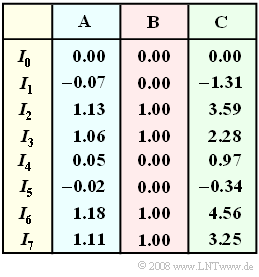Exercise 3.09: Correlation Receiver for Unipolar Signaling
The joint decision of N=3 binary symbols ("bits") by means of the correlation receiver is considered.
The M=8 possible source symbol sequences Qi all have the same probability and they are defined by the following unipolar amplitude coefficients:
- Q0=000,Q1=001,Q2=010,Q3=011,Q4=100,Q5=101,Q6=110,Q7=111.
Further applies:
- The possible transmitted signals si(t) – each with duration 3T – are all rectangular with the exception of s0(t)≡0.
- The signals s1(t), s2(t) and s4(t) with only one "1" each have the signal energy EB (stands for "energy per bit"), while for example the energy of s7(t)=3EB.
The correlation receiver forms from the noisy received signal r(t)=s(t)+n(t) a total of 23=8 decision variables (metrics)
- Wi=Ii−Ei/2withIi=∫3T0r(t)⋅si(t)dt(i=0,...,7)
and sets the sink symbol sequence V=Qj, if Wj is larger than all other Wi≠j. Thus, it makes an optimal decision in the sense of "maximum likelihood".
In the table, the (uncorrected) correlation values I0, ... ,I7 for three different systems differing in terms of noise n(t) and labeled A, B or C.
- One of these columns stands for "no noise",
- one for "minor noise", and
- another one for "strong noise".
Note:
- The exercise belongs to the chapter "Optimal Receiver Strategies".
- The same source symbol sequence was always sent to determine the metrics for the three system variants.
Question
Solution
- For system B, metrics "0" occur four times and metrics "1" occur four times.
- This points to n(t)=0, otherwise – as in systems A and C – all Ii would have to differ.
(2) For system B, the decision values Wi=Ii −Ei/2, each normalized to EB, are as follows:
- W0=0−0=0,W1=0−0.5=−0.5,
- W2=1−0.5=0.5,W3=1−1=0,
- W4=0−0.5=−0.5,W5=0−1=−1.
- W6=1−1=0,W7=1−1.5=−0.5.
- The maximum value W2=0.5 ⇒ i=2.
- Thus, the correlation receiver decides to use V=Q2.
- Since there is no noise, Q2= "010" was indeed also sent ⇒ k=2_.
(3) For the decision values of system A holds:
- W0=0.00−0.00=0.00,W1=−0.07−0.50=−0.57,
- W2=1.13−0.50=0.63,W3=1.06−1.00=0.06,
- W4=0.05−0.50=−0.45,W5=−0.02−1.00=−1.02,
- W6=1.18−1.00=0.18,W7=1.11−1.50=−0.39.
- The maximum is = Wj=W2 ⇒ j=2_.
- This means that the correlation receiver also makes the correct decision V=Q2 for system A.
- However, without the correction term (– E_i/2), the receiver would have made the wrong decision V = Q_6.
(4) The correlation receiver \rm C has to compare the following values:
- W_0 = 0.00 - 0.00 = 0.00, \hspace{0.2cm}W_1 = -1.31 - 0.50 = -1.81 \hspace{0.05cm},
- W_2 = 3.59 - 0.50 = 3.09, \hspace{0.2cm}W_3 = 2.28 - 1.00 = 1.28 \hspace{0.05cm},
- W_4 = 0.97 - 0.50 = 0.47, \hspace{0.2cm}W_5 = -0.34 - 1.00 = -1.34 \hspace{0.05cm},
- W_6 = 4.56 - 1.00 = 3.56, \hspace{0.2cm}W_7 = 3.25 - 1.50 = 1.75 \hspace{0.05cm}.
The maximization here gives \underline {j = 6} ⇒ V = Q_6.
- But since Q_2 was sent, the correlation receiver decides wrong here.
- The noise is too strong.
(5) Solution 3 is correct:
- The noise is greatest for system \rm C and is even so great for the current received values that the correlation receiver makes an incorrect decision.
(6) Statements 1 and 3 are correct:
- In the error-free case (system \rm B), the difference between W_2 = 0.5 and the next largest values W_0 = W_3 = W_6 = 0 is equal to D_{\hspace{0.02cm}\rm min} =0.5 in each case.
- In system \rm A (light noise), the difference between W_2 = 0.63 and the next largest value W_6 = 0.18 is still D_{\hspace{0.02cm}\rm min} = 0.45.
- If the noise power is increased by factor 50, the correlation receiver still decides correctly, but then the minimum difference D_{\hspace{0.02cm}\rm min} = 0.16 is significantly smaller.
- For system \rm C, where the correlation receiver is overcharged ⇒ subtask (4), a noise power larger by a factor of 400 compared to system \rm A was used as a basis.
- If the correlation receiver decides the transmitted sequence Q_2 incorrectly, a falsification to the sequences Q_0, Q_3 resp. Q_6 is most likely,
since all these three sequences differ from Q_2 only in one bit each.
- The fact that W_6 is always larger than W_0 or W_3 in the described simulation is "coincidence" and should not be overinterpreted.
